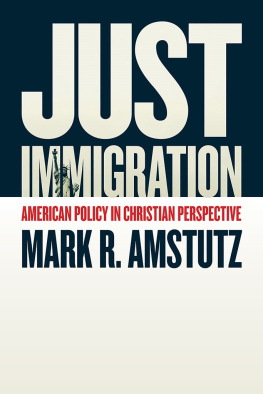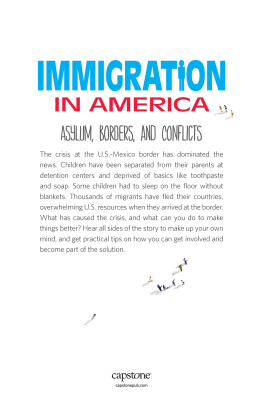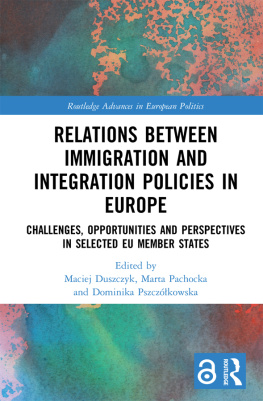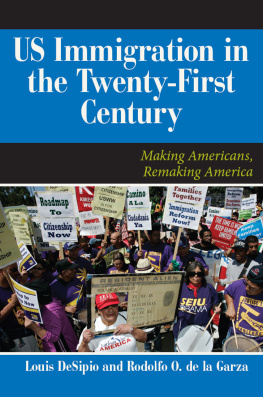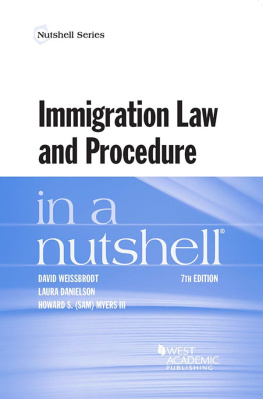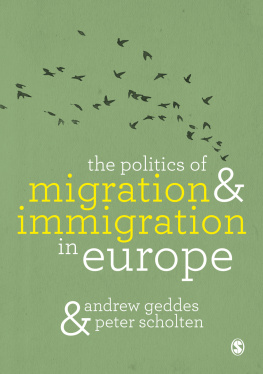Published by State University of New York Press, Albany
2017 State University of New York
All rights reserved
Printed in the United States of America
No part of this book may be used or reproduced in any manner whatsoever without written permission. No part of this book may be stored in a retrieval system or transmitted in any form or by any means including electronic, electrostatic, magnetic tape, mechanical, photocopying, recording, or otherwise without the prior permission in writing of the publisher.
For information, contact State University of New York Press, Albany, NY
www.sunypress.edu
Production, Ryan Morris
Marketing, Kate R. Seburyamo
Library of Congress Cataloging-in-Publication Data
Names: Hoskin, Marilyn B., 1945 author.
Title: Understanding immigration in an era of mass population movement / Marilyn Hoskin.
Description: Albany : State University of New York Press, [2017] | Includes bibliographical references and index.
Identifiers: LCCN 2016053170 (print) | LCCN 2017022141 (ebook) | ISBN 9781438466897 (ebook) | ISBN 9781438466873 (hardcover : alk. paper) | ISBN 9781438466880 (pbk. : alk. paper)
Subjects: LCSH: Emigration and immigrationGovernment policyCase studies. | United StatesEmigration and immigrationGovernment policy. | Great BritainEmigration and immigrationGovernment policy. | GermanyEmigration and immigrationGovernment policy. | FranceEmigration and immigrationGovernment policy.
Classification: LCC JV6271 (ebook) | LCC JV6271 .H67 2017 (print) | DDC 325/.1dc23
LC record available at https://lccn.loc.gov/2016053170
10 9 8 7 6 5 4 3 2 1
Contents
CHAPTER 1
Immigration as a Never-ending Saga
CHAPTER 2
The United States: Immigration Model or Nation of Continuous Conflict?
CHAPTER 3
Great Britain: Reluctant Parent to the Former Empire
CHAPTER 4
Germany: Denial, Acceptance, Recruitment of Immigrants
CHAPTER 5
France: Haven or Hell for Foreigners?
CHAPTER 6
Comparing Immigration Lessons across Nations
Preface and Acknowledgments
Immigration has become one of, if not the top, hot-button issues of the twenty-first century. However urgent questions of border violations, overcrowded urban ghettos, or cultural differences appeared to be in earlier times, the combination of terrorist attacks and seemingly uncontrolled flow of refugees into the United States and Europe since 2001 have made immigration the epicenter of a host of new challenges: strident national election campaigns, increasing instances of hate crimes, paralyzed and unresponsive legislatures. More generally, population movements have highlighted the permanent consequences of globalization, fractured societies, human and natural disasters. If immigration has always tested the resilience of governments and citizens, its emergence as a global force surpassing all previous levels presents a challenge of historic proportions.
While no part of the 2016 world has been exempt from this challenge, it is especially poignant in the United States and Europe as highly sought destinations for millions of actual and potential immigrants. The nations included in this study were selected to represent that status, but also to provide essential variations in their experience with immigration. The United States is an obvious choice for a long history with migration and a national definition based on the diversity of its population. The three European states offer markedly different histories, which nonetheless led to common needs for labor, for government policies to legitimize immigrants chosen for admission, and for widespread adaptation to pluralist societies. Studied together, they provide assessment of a broad range of factors, which should assist in explaining both the evolution of immigration in the past century and the options nations have in dealing with it as an ongoing challenge.
My history with the study of immigration began with undergraduate and graduate work in Germany in 1966 and 1971, when the first migrants were working as temporary labor there. They lived mostly in crowded quarters in urban centers, socialized in the central railroad stations, and only rarely had families in residence, but sheer numbers and obvious need for their labor invited further study. A 198081 Fulbright leave in Mannheim provided that opportunity, and led to publication of a series of articles and, ten years later, a book comparing public opinion toward immigrants in Germany and three other nations (Britain, Canada, and the United States). Years of teaching about immigration brought two conclusions. First, students had little knowledge of the rich and varied immigration experiences so important to understanding their own nations contemporary challenges, and second, real understanding would require that they systematically compare critical components of immigration in their own and other nations. Since immigration is a classic example of a topic crossing academic disciplines, that would mean exposing them to geographic, historical, economic, and political analyses. This book is a first step in facilitating such understanding.
Including four distinctive nations, and framing the immigration challenge in terms of four important components, allows the reader to step back from immediate situations to evaluate them in the context of multiple forces, which define this critical issue across very different settings. It also, however, runs the inevitable risk of emphasizing breadth over depth in any of the areas considered. For those new to the topic, however, this approach has the advantage of introducing key elements that cause variation or similarity in nations confronting the challenge of twenty-first-century immigrationsome for the first time, some as a new chapter in a longer history. If it does not produce definitive answers to current issues (it certainly does not), it points students to areas where they can pursue further exploration, in disciplines they might have otherwise avoided. If this kind of introduction leads to expanding knowledge of the many dimensions of immigration, it will have served its primary purpose.
The book has relied on a host of sources and careful studies undertaken by others, including scholars, university and other nonprofit institutes dedicated to providing data and analysis of important issues, and, of course, data collected by national governments and international organizations and made available for scholarly and general analysis. Government departments in all four nations collect and make publicly available vast databases, quarterly and annual reports, and volumes of organized data displaysthe Office of National Statistics (ONS) in Britain, the National Institute for Statistics and Economic Studies (INSEE) in France, the Federal Office for Migration and Refugees in Germany, the Census Bureau and Department of Homeland Security in the United States. In addition, several regional and international organizations collect and distribute data on a regular basis; the United Nations Office of the High Commission on Refugees (UNHCR) and the Organization for Economic Cooperation and Development (OECD) have been especially useful for this project. To optimize reliability of high quality survey data, I have limited use of public opinion surveys to those produced by established survey research and polling organizations that utilize national samples and standard or carefully tested question formats. Most make their data and overall results available through the Inter-University Consortium for Political and Social Research, whose collection includes national election studies in the U.S., Britain, and Germany, the more general social surveys conducted by the National Opinion Research Center, the Eurobarometer series sponsored by the European Union, the German Omnibus (Allbus) surveys. Polling divisions of national news services have added multiple perspectives on public views, over time, and this wide collection provides best evidence of the state of opinion in the nations studied here. The Pew Research Center has a large and diverse array of survey data, again available to scholars for secondary analysis and reproduction. Important studies published by scholars of American and European immigration have been listed as sources of further information in each of the chapters as well.



